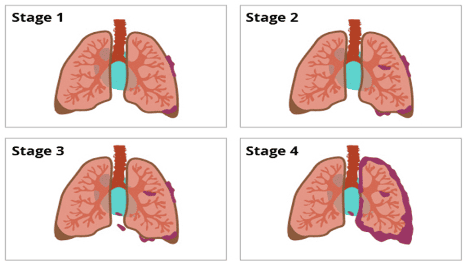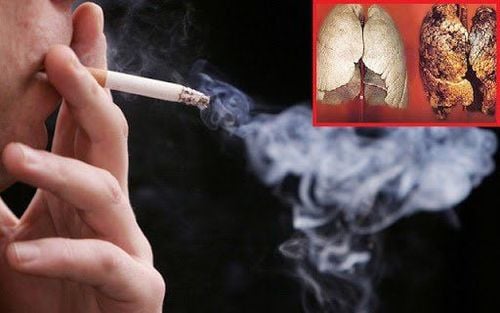This is an automatically translated article.
Article written by Master, Doctor Mai Vien Phuong - Gastroenterologist - Department of Medical Examination & Internal Medicine - Vinmec Central Park International General Hospital.
Squamous cell lung cancer is a type of non-small cell lung cancer. It is classified based on the image of the cancer cells under the microscope. According to the American Cancer Society, most (about 80%) of lung cancer cases are non-small cell. Of these, about 30% are squamous cell carcinomas.
1. What is squamous cell lung cancer?
Squamous cell lung cancer begins in the top layer of cells, called squamous cells, which line the large airways (bronchi) of the lungs. It usually develops in the branching bronchi of the main bronchus, to the left or right center of the chest.There are four subtypes of squamous cell lung carcinoma. A DNA study of the subtypes found the following features:
Primitive carcinoma is the least common of the four types. Classical carcinoma is the most common subtype. It occurs frequently in male smokers. Secretory adenocarcinoma grows slowly. Basal cell carcinoma is very rare. It tends to occur at an older age. Of all the types of non-small cell carcinoma, squamous cell lung cancer is most associated with smoking.

2. Symptoms of squamous cell lung cancer
The most common symptoms of squamous cell lung cancer are:Persistent cough. Bloody sputum. Shortness of breath or difficulty breathing. Chest pain, especially when breathing. Unexplained weight loss. Reduced appetite. Tired.
Trắc nghiệm: Hiểu về phổi của bạn
Phổi là một tạng lớn rất quan trọng và không thể thiếu trong cơ thể. Việc giữ cho lá phổi của bạn luôn khỏe mạnh, tránh khỏi những bệnh phổ biến về phổi là điều bạn cần lưu ý để giúp cơ thể bạn có thể vận hành tốt. Hãy cùng chúng tôi trả lời nhanh những câu hỏi trắc nghiệm sau sẽ giúp bạn hiểu về phổi của bạn hơn.
Bài dịch từ: webmd.com
The following content is prepared under supervision of Thạc sĩ, Bác sĩ y khoa, Nguyễn Huy Nhật , Nội Hô hấp , Khoa Khám bệnh & Nội khoa - Bệnh viện Đa khoa Quốc tế Vinmec Đà Nẵng
3. How does squamous cell lung cancer occur?
Squamous cell lung carcinoma forms in the cells lining the bronchi. Over time, cancer can spread by invading lymph nodes and nearby organs and traveling through the bloodstream (metastasize) to other parts of the body.Doctors use the size, location, and spread of the tumor to classify cancer into stages. Using the TNM system, cancers can be subdivided into: Primary tumors (T), tumors that have spread to the lymph nodes (N), and distant metastatic tumors (M). They are then combined to classify the cancer into a specific stage. There are a total of 6 main stages. Stages 1 to 4 are broken down by the size, number and location of the tumor:
Hidden stage In this stage, there are cancer cells in the sputum but no tumor can be found.
Stage 0 The cancer is only in the lining of the bronchi and not in the lung tissue. This is also called carcinoma in situ.
Stage 1 Cancer is only in the lungs. It has not spread to the lymph nodes around it or to other parts of the body.
Stage 2 The cancer is in the lung tissue and has spread into the lining of the lung or nearby lymph nodes but has not spread further.
Stage 3 The cancer is in the lung tissue and has spread to nearby lymph nodes or organs; such as the esophagus or heart but has not spread to distant organs.
Stage 4 The cancer is in the lung tissue and has spread to one or more distant parts of the body. Non-small cell lung cancer usually spreads to:
Liver.
Brain.
Adrenals .
Skeletal.
Stage 4A means the cancer has spread as a tumor, it has spread to another lung or to the fluid around the heart or lungs (causing pericardial effusion). In stage 4B, the cancer has spread as two or more tumors.

4. Causes of squamous cell lung carcinoma
Causes of squamous cell lung cancer include:Smoking
Of all the causes of squamous cell lung cancer, smoking is the leading cause. According to the National Cancer Institute, regular smokers are 10 times more likely to develop all types of lung cancer than those who smoke less than 100 cigarettes.
The more you smoke and the longer you smoke, the higher the risk. If you quit smoking, your risk of lung cancer goes down but remains higher than that of non-smokers for several years after quitting. The risk of lung cancer for cigar and pipe smokers is as high as for cigarettes.
Radon exposure
Radon is the second most common cause of lung cancer in general and the most common cause of lung cancer in non-smokers.
Radon is a radioactive, odorless, invisible gas that comes from rocks and soil. In enclosed places such as indoors there are higher concentrations of radon. People who both smoke and are exposed to radon gas have a much higher risk of lung cancer.
Exposure to secondhand smoke
Exposure to smoke is the third most common cause of lung cancer.
Other causes
Other causes include:
Long-term exposure to carcinogens. Examples include asbestos, arsenic, cadmium, nickel, uranium and some petroleum products. Air pollution . Poor air quality can be a cause of disease initiation or exacerbation. Exposure to radiation. You may be exposed to radiation during previous treatment with radiation therapy to the chest or from an X-ray. Anamnesis. A personal or family history of lung cancer increases the risk of developing lung cancer. If you've had lung cancer, you're at higher risk of getting it again. If your loved one has lung cancer, you have a higher risk of developing the disease.

5. Diagnosis of squamous cell lung carcinoma
To diagnose squamous cell lung cancer, your doctor will first ask you about your symptoms and conduct an exam. Next, they will perform one or more diagnostic tests depending on your history, symptoms, condition, and tumor location. These tests may include:Lung imaging
Usually, a chest X-ray will be done first. A CT or MRI scan will then be taken to get a better look at your lungs and look for tumors and signs that the cancer has spread.
Get some cancer cells
There are several ways a doctor can get these cells. They may take a sputum sample. The fluid around your lungs also often contains some cancer cells. Your doctor may also take a needle sample through your skin (thoracentesis). Then, your cells are examined under a microscope for signs of cancer.
Biopsy
A biopsy is another way to look at cells under a microscope. Your doctor may take a biopsy of the tumor using a needle inserted through the skin (needle biopsy) or a tube with a light and camera inserted through your mouth or nose (bronchoscopy). .
If the cancer has spread to lymph nodes or other structures in your lungs, your doctor may do a biopsy through an incision in your skin (mediastinoscopy).
PET scan
This is an imaging test that shows a spot in any tissue that has cancer. PET scans are used to look for metastases near the tumor or in the body.
Bone scan
This is an imaging test that shows a spot in the bone where the cancer has spread.
Lung function tests
These tests check how well your lungs are working. They are used to show if you have enough lung function after surgery to remove lung tissue with a tumor.
6. Treatment of squamous cell lung carcinoma
Treatment for squamous cell lung cancer depends on how advanced the cancer is, your tolerance for side effects, and your overall health. Age is usually not considered. Treatments are individualized, but there are some general guidelines for treatment at each stage.Hidden stage cancer
If you have cancer cells in your sputum but no cancer is found with diagnostic tests, you will usually undergo routine diagnostic tests (such as bronchoscopy or CT scan) until a tumor is found.
Stage 0
Surgery to remove the tumor and the lungs around it without chemotherapy or radiation usually cures squamous cell carcinoma at this stage.
Stage 1
Single surgery usually works at this stage. Some lymph nodes are usually removed to see if cancer has spread to them. If the risk of the cancer coming back is high, you may have chemotherapy after surgery. Sometimes, radiation therapy is used instead of chemotherapy.
Stage 2
This stage is usually treated with surgery to remove the tumor and lymph nodes, followed by chemotherapy to kill any remaining cancer cells.
If the tumor is large, you may have chemotherapy and radiation or just radiation before surgery to make the tumor smaller and easier to remove with surgery.
Stage 3
Surgery can remove some but not all of the cancer in this stage because it has spread to the lymph nodes in your neck or important structures in your chest. Chemotherapy and radiation are usually given after surgery.
Stage 4
In this stage, the cancer has spread throughout your body. Treatment depends on your overall health and how much cancer has spread. If you're healthy enough for surgery, you can combine surgery, chemotherapy, and radiation.
Other therapies may be added to your treatment or used if surgery is not appropriate such as:
Immunotherapy. This strengthens the immune system's ability to fight cancer. Targeted therapy based on gene mutations. This is therapy that targets specific features and mutations of cancer cells. Clinical trials. When you are eligible to receive new treatments that are being studied and proven to be effective. If treatment does not work or a person decides to stop treatment, palliative care will usually be provided. This is supportive care used to improve the quality of life for people with terminal cancer. It can help relieve cancer symptoms as well as provide emotional support to the person with cancer and their loved ones. Hospice is palliative care performed when life expectancy is less than six months.

7. Treatment prospects
The effectiveness of treatment for non-small cell lung cancer, such as squamous cell carcinoma, is better than for small cell lung cancer. It can even be cured when detected and treated early. .The outlook for people with cancer is measured by the 5-year survival rate. This number shows the percentage of people with a particular type of cancer who are alive 5 years or more after being diagnosed.
According to the American Cancer Society, the median 5-year survival rate for non-small cell lung carcinoma by cancer stage is:
Stage 1A: 84%. Stage 2A: 60%. Stage 3A: 36%. Stage 4A: 10%. Stage 4B: Less than 1%. The percentages above are only averages and are not applicable to individuals. An individual's outlook is influenced by many factors; such as age, general health, response to treatment, and side effects of treatment. Your doctor will evaluate all of this information to give you a specific outlook.
However, the percentages show that the key to the best survival is early detection and treatment before the cancer has metastasized. You can greatly reduce your risk of lung cancer by not smoking. If you smoke and receive a diagnosis of lung cancer, quit before it's too late.
Lung cancer can be treated with surgery, radiation and chemotherapy. Surgery is being developed in the direction of minimizing invasiveness, minimizing damage to the patient; eg thoracic surgery, robotic surgery. Recent radiotherapy techniques focus on treating specific tumors, on individual organs and depending on the patient population for a certain period of time.
At Vinmec International General Hospital, patients can be treated with SBRT - a radiosurgery technique using whole-body positioning, accurate to millimeters. SBRT is an alternative to surgery, shorter treatment time, high scoring accuracy, better results and simpler procedure than traditional radiotherapy.
In recent years, chemotherapy for lung cancer has also made a lot of progress. Particularly striking are new targeted therapies in patients with molecular genetic abnormalities. Among them, the therapy to strengthen the autologous immune system to support the treatment of lung cancer patients is a remarkable breakthrough.
Please dial HOTLINE for more information or register for an appointment HERE. Download MyVinmec app to make appointments faster and to manage your bookings easily.















